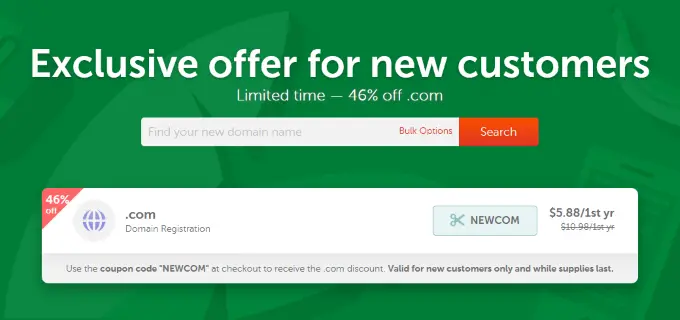For a professional touch that looks great on resumes and business cards.
A JobMob reader asked:
I have a professional question. Do you know how someone gets a domain name that is their name? As in jacob@jacobshare.com?
There are actually 2 parts to the question:
- How to get a domain name?
- How do I get my own domain name for a website and/or email?
Let's do this.
Get 46% off a new .com domain until February 19th, 2019
How to get a domain name
First, a little terminology.
www.jobmob.co.il?utm_source=rss&utm_medium=rss is a fully-qualified domain name where:
- www is the hostname
- jobmob.co.il is the domain name, and
- .il is a country-code top-level domain or ccTLD, or even just TLD for short.
Before looking, you need to know what you’re looking for.
A good format to start with is firstnamelastname.com, because if anyone is likely to guess what your personal website would be, that’s probably the first address they would guess if you’re in America, at least. Otherwise, aim for the most popular TLD in your own country such as .ca or .co.uk.
If you have a middlename, you could also look for firstnamemiddlenamelastname.com but only do this if your middlename is used in your personal brand name, in which case you should aim for this format BEFORE trying for firstnamelastname.com.
Next, before you can buy your domain (or any other), you need to check if it’s even available and not already owned or being used by someone else.
This is one time where a Google search is NOT the best way to go.
Instead, you would do what’s called a “WHOIS search” using a site such as… what else… who.is. You simply type in the domain name you’re looking for, and click to search. The results will tell you who owns it or that it isn’t owned at all, in which case you can buy it via a domain name registrar, an online seller of domain names.
Better yet, do the whois search via a reputable domain name registrar because if the domain is available, the registrar might propose a discount to “buy it now!” or propose a similar domain that you can “buy now!”
I use and recommend Namecheap, which has a monthly coupon for discounts on new domain registrations. I’ve been with them since 2006, and they have great customer support too. (I like their text chat support service, which I've used both from my PC and my smartphone.)
What happens if your domain is NOT available?
You could try to buy it from the current owner, but that can get expensive. It’s a lot easier to:
- Change TLDs and buy the e.g. .net or .org version instead of the .com version of the domain, or
- Change the format e.g. buy firstname-lastname.com or lastnamefirstname.com
Of these two options, it’s much better to change the TLD. People are more likely to remember firstnamelastname.net than a hyphen or lastnamefirstname.
Namecheap‘s search will automatically tell you if the domain is available with dozens of different TLDs.
Once you find an available domain, create a Namecheap account and buy your domain. It only takes a minute.
Now you're ready to use it for a personal website and your own branded email address (which would be a great job search email address, if you don't already have one).
How to get an email address or website with your domain name
If you bought the domain name for personal branding purposes, the most common thing to do with the domain – by far – is to use it for your personal brand's website.
Less common – but almost as impressive – is to use the domain for your email too.
When you surf the web, the webpages you visit are simply groups of files that your browser copied from another computer over the Internet.
Likewise, when you check your email in software such as Outlook/Thunderbird/etc., the messages you download are simply groups of files that your email software copied from another computer over the Internet.
In both cases, that other computer is called a server because your computer (the client) is asking it to serve (give) files that it hosts or stores.
To find the different kinds of files being hosted, we use a different hostname.
For example, my business email used to be served from mail.shareselectmedia.com and my business website was once served from www.shareselectmedia.com,?utm_source=rss&utm_medium=rss but nowadays, most servers are configured so that if no hostname – in this case, www – is specified, the server will automatically assume you want to see the website at e.g. shareselectmedia.com.
Now that you understand that your website and email need to be hosted on a server somewhere, how do you actually make that happen with your new domain name?
Your options are:
- Personal hosting
- Web and email hosting with separate companies
- Web and email hosting with the same company
1) Personal hosting
This is the Do It Yourself option.
You configure your home computer (or a computer in your home) to host and serve both your website and your email using your domain name.
As you can imagine, this setup requires significant technical skill.
I don't recommend you take this route unless you know what you're doing, and even then I probably wouldn't recommend it.
2) Web and email hosting with separate companies
Much less complicated than the first option but still somewhat complicated because it involves managing accounts at different companies, this option tends to be the one preferred by people with very specific needs.
You might consider this option if you want to build your personal website using blog platforms like WordPress.com (not self-hosted WordPress) or Tumblr or a click-to-build platform like Wix.
In my case, all my websites are currently hosted with WPX Hosting, and because I like Gmail, my work email is hosted on G Suite, the business version of Gmail/Google Docs/etc.
Since my work email uses the shareselectmedia.com domain which is registered with Namecheap, that's where I needed to configure the domain to work with G Suite.
However, even this simpler option is overly complicated for most people. If that's you, choose the next option.
3) Web and email hosting with the same company
Many people choose this option, especially the first time around like I did, and it's often the best choice for quality vs. simplicity.
A typical scenario involves buying a hosting plan with a hosting provider.
When I first started my company, all my sites and my corporate email were hosted from the same server at a well-known hosting provider based in California. I used their cheapest plan at $20 per month, but unless you expect to have a lot of traffic to your website like I did, you can find cheaper hosting options.
Many hosting providers throw in a free domain registration when you sign up for such a yearly plan, but DO NOT use this freebie to register your personal brand domain, register it with a separate domain name registrar. (This will save you headaches if you ever decide to change hosting companies, because sometimes the fine print says that you don't even own the free domain you received on joining.)
Any decent hosting provider will have technical support who can setup your email and website to use your domain name or at worst, help you do it yourself.
They will also usually have an administration panel and tutorials explaining which forms to fill in and which boxes to check. You'll only have to do it once and since it's so common a task for the hosting company's clients, the admin panel should make it very simple.
My recommendation in this case is again to use Namecheap, which offers both cheap email hosting and web hosting services (for only a few dollars per month, combined), and get their great tech support to help configure your new domain name for whatever you need.
If you're wondering how to get your own domain name on Gmail like I did, Namecheap makes it really easy to do.
Get 46% off a new .com domain until February 19th, 2019
Question of the article
Have you bought a domain before? If so, who is your favorite domain registrar and why?
A version of this article originally appeared on personalbrandingblog.com.
READ NEXT:  7 Signs You're Actually An Expert On Anything
7 Signs You're Actually An Expert On Anything
Subscribe to JobMob via RSS or email and follow me on Twitter for more How Tos for critical job search tools.
via JobMob More Information Here..



No comments:
Post a Comment